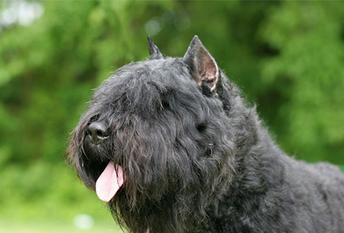The Spinone has a dense, wiry coat that resists weather and protects him from brush and debris. As he has no undercoat, he needs only occasional brushing and hand stripping to remove dead hair. For stripping your Spinone’s coat, you can use either a stripping knife (don’t worry – it won’t cut your dog) or your bare hands. Your breeder can show you proper technique, and how to tell how much hair needs to be stripped. Because of his harsh coat, he will only need a bath if he gets into something really gross.
You may want to keep a hand towel close by when your Spinone gets a drink because afterward his beard will drip water all over the place.
Check the ears on a weekly basis for signs of infection, irritation, or wax build up. Cleanse regularly with a veterinarian-approved cleanser and cotton ball. Brush the teeth at least once per week to prevent tartar buildup and fight gum disease. Additionally, nails should be trimmed once per month if the dog does not wear down the toenails naturally.
Spinones are highly energetic and should be exercised vigorously for at least an hour each day. Spinones enjoy long jogs and their adaptability to various terrains makes them excellent hiking companions.While a hike or walk is always a good idea, it is not something that must be done every day. A large, securely fenced yard and plenty of playtimes will keep a Spinone happy, along with being part of the family, which is just as important to his well-being asexercise.Spinonesare not “kennel dogs,” or dogs who can just be left alone outside—they must be part of the family at all times, which means being a house dog, living inside with the family.
Spinones are highly energetic dogs and require a well-balanced diet. Keep in mind that their shaggy beards can leave trails of water around a home after a drink.
If you get a Spinonespuppy from a breeder, they would give you a feeding schedule and it's important to stick to the same routine, feeding the same puppy food to avoid any tummy upsets. You can change a puppy's diet, but this needs to be done very gradually always making sure they don't develop any digestive upsets and if they do, it's best to put them back on their original diet and to discuss things with the vet before attempting to change it again.
Older dogs are not known to be fussy or finicky eaters, but this does not mean you can feed them a lower quality diet. It's best to feed a mature dog twice a day, once in the morning and then again in the evening, making sure it's good quality food that meets all their nutritional requirements. It's also important that dogs be given the right amount of exercise so they burn off any excess calories or they might gain too much weight which can lead to all sorts of health issues. Obesity can shorten a dog's life by several years so it's important to keep an eye on their waistline from the word go.
Some Spinoni can experiencebloat, which can be related to the very sensitive nature of the breed. Because Spinoni will worry more when their owners are worried, this can create a vicious cycle in terms of the dog not eating or possibly stressing himself into bloat. Making sure the Spinone has quiet time to digest after eating in order to help prevent bloat is important.
The average life span of the Spinone Italiano is 12 to 14 years. Breed health concerns may include cerebellar ataxia andhip dysplasia.
Responsible breederswill screen their stock for health conditions such as hip and elbow dysplasia and eye anomalies. As with all breeds, the Spinone’s ears should be checked regularly for signs ofinfection, and theteethshould be brushed often, ideally every day, using a toothpaste formulated for dogs.
One experienced breeder shares insight on breed trainability: “Spinonesare very soft, very stubborn, and very smart. Training is mostly about ‘barter.’ With many breeds, if you say, ‘Jump,’ they will ask, ‘How high?’ as they are jumping, whereas a Spinone will ask, ‘Why?’ You can teach a Spinone the basics and even train them for competitive obedience—just don’t expect them to be ‘high and tight’ about it every single time. They may tell you, ‘No, not today. Maybe later.’ They are smart, but a challenge and they will shut down if training is too hard or harsh. When hunting, they hunt where they want and will put food on your table.Spinonesare not ‘robot hunters’ who will go where you tell them to.Spinonesteach hunters to trust their dogs in the field.”
Spinones are reserved dogs who need extensive socialization as puppies to help them come out of their shells. If not properly introduced to new people, new situations and other animals, a Spinone can be very difficult to live with. When properly socialized, he may still be cautious around strangers, but will always be polite and dignified.











